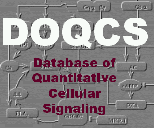| |
Reaction
Name | Pathway Name /
Pathway No. | Kf | Kb | Kd | tau | Reagents |
| 1 | Ca-bind-to-Trans
p | CaRegulation
Pathway No. 110 | 3600
(uM^-2 s^-1) | 144
(s^-1) | Kd(af) = 0.2(uM) | - | Substrate:
Ca
Ca
CaTransp
Products:
CaTransp-2Ca
|
| Rates from Lauffenburger abd Linderman 1993 Receptors pg 200. Kd = KCa2 = 0.2 uM | | 2 | CaTraspATPase | CaRegulation
Pathway No. 110 | 25
(s^-1) | 0
(#^-2 s^-1) | Not applicable** | - | Substrate:
CaTransp-2Ca
Products:
CaTransp
Ca-sequester
Ca-sequester
|
| kCa3 = 2 * Ca transporter rate since each step has 2 Ca++. = 0.5 uM/sec from Lauffenburger and Linderman 1993 Receptors pg200 The amount of the activated transporter is about 0.01 uM = 6e3#. from runs. So 0.01uM * kf * 2 = 0.5 uM/sec (no back reaction) so kf = 25, kb = 0 Alternatively, 6e3 * kf = 0.25 * 6e5, giving the same kf | | 3 | IP3Rbind | CaRegulation
Pathway No. 110 | 0.05
(uM^-3 s^-1) | 1
(s^-1) | Kd(af) = 2.7144(uM) | - | Substrate:
IP3R
IP3
IP3
IP3
Products:
IP3R*
|
| Based on Lauffenburger and Linderman 1993 Receptors pg 200. The binding of IP3 on this reaction had a Hill coeff of 3. The eqns of Mahama and Linderman (cited in the book as 1993 a) are equivalent to the binding all occurring in a single step, so that is how I do it in this version. Their Ki1 is 0.07 uM. Lots of other data sources: Ramos-Franco et al, Biophys J 75, 1998: 834-39 have Ca sensitivity curves. At 250 nM free Ca, the EC50 for type1 is 58 nM and type 2 is 194 nM. Type 3 would be about 2 uM according to Newton et al, JBC 268(46), 1994: 28613-19. For the purposes of this model we use a Kd of 2.7 uM which is high but maybe OK at low calcium. The details of Ca interaction with the IP3R are not included in this model. | | 4 | Ca5-bind-Cal | CaRegulation
Pathway No. 110 | 0.0005
(uM^-5 s^-1) | 1
(s^-1) | - | - | Substrate:
Calseq
Ca-sequester
Ca-sequester
Ca-sequester
Ca-sequester
Ca-sequester
Products:
Ca5-Cal
|
| There are actually 5 Ca-sequester substrates for this reaction, along with one Calseq. Due to system limitations only four are entered. | | 5 | Ca10-bind-Cal | CaRegulation
Pathway No. 110 | 0.0005
(uM^-5 s^-1) | 1
(s^-1) | - | - | Substrate:
Ca5-Cal
Ca-sequester
Ca-sequester
Ca-sequester
Ca-sequester
Ca-sequester
Products:
Ca10-Cal
|
| There are actually 5 Ca-sequester substrates for this reaction, along with Ca5-Cal. Due to system limitations only four are entered. | | 6 | Ca15-bind-Cal | CaRegulation
Pathway No. 110 | 0.0005
(uM^-5 s^-1) | 1
(s^-1) | - | - | Substrate:
Ca10-Cal
Ca-sequester
Ca-sequester
Ca-sequester
Ca-sequester
Ca-sequester
Products:
Ca15-Cal
|
| There are actually 5 Ca-sequester substrates for this reaction, along with Ca10-Cal. Due to system limitations only four are entered. | | 7 | Ca20-bind-Cal | CaRegulation
Pathway No. 110 | 0.0005
(uM^-5 s^-1) | 1
(s^-1) | - | - | Substrate:
Ca15-Cal
Ca-sequester
Ca-sequester
Ca-sequester
Ca-sequester
Ca-sequester
Products:
Ca20-Cal
|
| There are actually 5 Ca-sequester substrates for this reaction, along with Ca15-Cal. Due to system limitations only four are entered. | | 8 | Ca30-bind-Cal | CaRegulation
Pathway No. 110 | 0.0005
(uM^-5 s^-1) | 1
(s^-1) | - | - | Substrate:
Ca25-Cal
Ca-sequester
Ca-sequester
Ca-sequester
Ca-sequester
Ca-sequester
Products:
Ca30-Cal
|
| There are actually 5 Ca-sequester substrates for this reaction, along with Ca25-Cal. Due to system limitations only four are entered. | | 9 | Ca35-bind-Cal | CaRegulation
Pathway No. 110 | 0.0005
(uM^-5 s^-1) | 1
(s^-1) | - | - | Substrate:
Ca-sequester
Ca-sequester
Ca-sequester
Ca-sequester
Ca-sequester
Ca30-Cal
Products:
Ca35-Cal
|
| There are actually 5 Ca-sequester substrates for this reaction, along with Ca30-Cal. Due to system limitations only four are entered. | | 10 | Ca40-bind-Cal | CaRegulation
Pathway No. 110 | 0.0005
(uM^-5 s^-1) | 1
(s^-1) | - | - | Substrate:
Ca-sequester
Ca-sequester
Ca-sequester
Ca-sequester
Ca-sequester
Ca35-Cal
Products:
Ca40-Cal
|
| There are actually 5 Ca-sequester substrates for this reaction, along with Ca35-Cal. Due to system limitations only four are entered. | | 11 | Ca25-bind-Cal | CaRegulation
Pathway No. 110 | 0.0005
(uM^-5 s^-1) | 1
(s^-1) | - | - | Substrate:
Ca-sequester
Ca-sequester
Ca-sequester
Ca-sequester
Ca-sequester
Ca20-Cal
Products:
Ca25-Cal
|
| There are actually 5 Ca-sequester substrates for this reaction, along with Ca20-Cal. Due to system limitations only four are entered. | | 12 | inactivate_cap_
Ca | CaRegulation
Pathway No. 110 | 0
(#^-2 s^-1) | 1
(s^-1) | Not applicable** | - | Substrate:
Ca-sequester
Ca-sequester
capacitive_Ca_
entry*
Products:
inact_cap_entry
|
| The Kd is set at about 3 uM so that at resting Ca the capacitative Ca entry is almost blocked. A 2nd order response makes the response steep. |
** This is a trasport reation between compartments of different volumes. Therefore Kd is not applicable. Please Note Kf, Kb units are in number of molecules instead of concentration